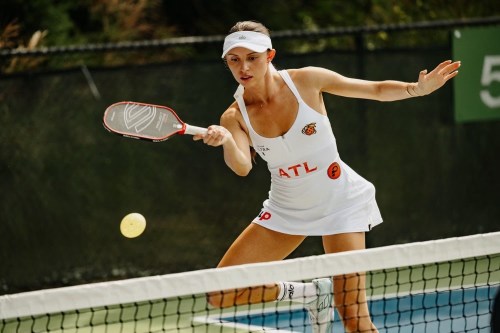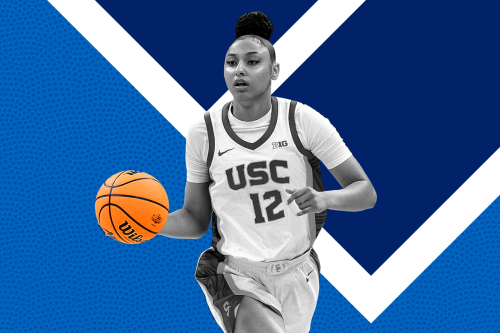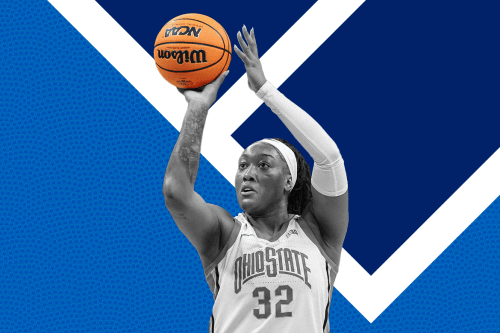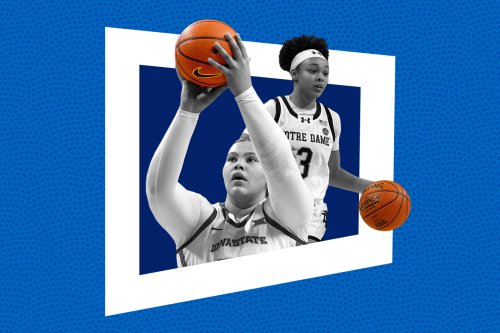A Pro Pickleball Player Shares 6 Secrets to a Stronger Pickleball Serve
A professional pickleball player’s top tips for developing accuracy and power in your pickleball serve, while still having fun.

As a tennis player who turned pro when she was just 14 years old, Parris Todd never thought she would find herself on a pickleball court, let alone that she would play the game—which she knew about primarily from her grandparents—professionally. The pandemic and resultant pickleball mania that swept the country changed everything.
Experts in This Article
professional pickleball player
“I started playing socially and it was just so much fun and it was such a different environment from tennis and the people were so much nicer,” Todd says. That gave her the itch to play more, and she started competing in tournaments—where, to her surprise, she would regularly lose to the fierce older ladies she played against. “After that I was like, okay, I’m actually going to do this for real and actually try to get good.”
The key came in learning many of the “soft shots” played close to the net that catch your opponent off guard. But before you make your way up to the net for those characteristically head-spinning rallies, Todd and every other pickleball player has to establish some dominance on the court with a powerful and strategic serve.
The pickleball serve is literally the opposite motion of the tennis serve. Instead of swiping above the head and down like in tennis, you serve underhand and hit from below the hip following through to over the shoulder. The serve must land in the back box opposite from where you’re serving, and a rule Todd says many forget is that you have to make contact with the ball below your hip.
“I see people serving above their hip all the time,” Todd says. “I see people serving from high to low. I see people not following over their shoulder. I see them not aiming, they’re just kind of hitting the serve to hit. So what I like to tell people if I’m coaching them is have purpose with your serve.”
How can you establish that purpose—and killer form to boot? Here are Todd’s top tips for developing a stronger pickleball serve.
6 tips for a stronger pickleball serve, according to a pro
1. Aim for the back of the court
The best pickleball players think several shots ahead, considering how they’ll deliver a killer drop shot to score when their opponent is coming from the other end of the court. Todd says the serve is the first strategic move because it’s all about keeping your opponent as far back—and away from the kitchen, where you’ll win most of your points—as possible.
“You want to try and hit it as deep as you can to keep your opponent back so they don’t come into the kitchen line quickly,” Todd says. “The slower they get into the kitchen line, the easier it is to hit it at their feet, and then they’re more likely to pop the ball up higher, so then you can hit down at their feet because you don’t want them to keep you back.”
2. Line up your body, and you’ll line up your pickleball serve
How do you ensure your ball gets where you want it to go in that opening move? With your body position. “Wherever your shoulders are pointing, you’re most likely to aim the ball,” Todd says. “If your shoulders are every which way, then the ball is going to go wherever. But if you have your shoulders pointed to where you want to aim, then it’s usually going in that spot.”
3. Keep a “Goldilocks” grip on your paddle
Todd says to think about the paddle as an extension of your arm. You need to keep some movement in your wrist, but still maintain control. If a “one” is a floppy handshake, and a “10” is a vice grip, you want to keep your handle on the paddle at a “five.”
Gold Medal Couple Tara Davis-Woodhall and Hunter Woodhall Talk Marriage, Motivation, and Their Next Chapter With Nike

Coach Kara Lawson Wants You to ‘Handle Hard Better’—and Here Are 3 Ways to Do Just That

JuJu Watkins Leaves March Madness With ACL Tear—and This Knee Injury Is More Common Than You Think

“The paddle is an extension of your hand,” she says. Todd suggests imagining what it would be like to hit the ball if you didn’t have a paddle, and just used your hand instead. “How would you then do that with your paddle?” Todd asks. “Keeping their wrist loose and really swinging through the ball is important.”
4. Follow through with your body and your mind
Like in most sports, keeping your eye on the ball will ensure you make good contact. Following through with your body—so swinging your arm up and over your shoulder—will help with aim and power.
“I like to start with my paddle where my right hip is,” Todd says. “From there you just swing from low to high, so you’re kind of brushing up on the ball to get that spin and also that height on the ball, and then you follow through over your opposite shoulder.”
Make sure not to lift that head until after you’ve made contact.
“When you toss the ball up, you definitely want to keep your head down,” Todd says. “You want to keep it down so you see where you’re making contact, and from there you can finish and bring your head up.”
5. Build consistency before building speed
For Todd, accuracy takes precedence over speed. In fact, trying to hit too fast before you’re comfortable with your serve can mess up your aim.
“Consistency is key first,” Todd says. “Once you can get consistent and get a feel for a slower speed, then from there you can pick up the speed, because I’d rather have people make the serve than miss the serve and go for too much.”
You want to have consistent aim around the height you’re hitting the ball in addition to where you’re placing it on the court. Todd recommends aiming to hit the ball a couple feet over the net.
6. Use your warmup to practice
Most pickleball players probably aren’t playing in professional tournaments like Todd is. But not seeing the improvement you want to can still be frustrating even if you’re just playing for fun. So while it may seem counterintuitive to the recreational nature of the sport to run drills and practice, there are easy ways to try to actively hone your skills.
“You go out and play games and that’s where the fun is, right?” Todd says. “But the improvement is in the repetition and the drilling.”
If you want to find a happy medium, Todd suggests planning to show up early to a game and practicing shots for 10 minutes beforehand. A favorite serve drill she likes to do is placing cones in different places around the court, and serving to the cones, not moving on to the next spot until she can hit the cone 10 times in a row.
“Say you practice 10 shots of each thing when you warm up, well say you do that three, four times a week, that starts to add up,” Todd says. “You start to really get a feel for those shots. As long as you have intention in your warm up, then it’s kind of like you’re drilling.”
Sign Up for Our Daily Newsletter
Get all the latest in wellness, trends, food, fitness, beauty, and more delivered right to your inbox.
Got it, you've been added to our email list.







